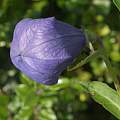Platycodon A.DC. commonly called Japanese or Chinese balloon flower is a single species genus of ornamental plants in the Campanulaceae family, native to East Asia including China, Japan and Korea.
Platycodon grandiflorus (Jacq.) A.DC. is classically blue, but is also available in white and pink, and in single and double varieties. The tuberous root is eaten and used in Chinese medicine. It is hardy to zone 4. It can be late to appear above ground in Spring and will die back before the first frosts. Variety mariesii Lynch (included in the species in 2025) discovered by Charles Maries is more compact. Buds bulge balloon like before popping open. F1 hybrid versions are sold as pot plants and will flower from seed in one season. Sowing seed early in the year indoors achieves the fastest progress to flowering because once the days start to shorten plants stop growing new foliage. Flowering time July. Height range: 1-2.5 ft. Photos by David Pilling, white form by Martin Bohnet.
Seed on a 1 mm grid, and seedling about two weeks after seed was exposed to moisture at 65 °F. Photo 3 is of the resulting roots on a 10 mm grid at the end of the year.
The next series of photos trace the development of the flower; it can be seen that by the time the pollen receptive stage is reached, in the next to last photo, the anthers and pollen have disappeared - the flower is 'protandrous'.
This sequence of photos shows ripe seed pods.

















